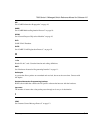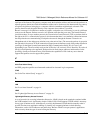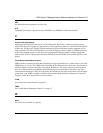
7000 Series L3 Managed Switch Reference Manual for Software v2.0
Glossary C-19
PHY
The OSI Physical Layer: The physical layer provides for transmission of cells over a physical medium
connecting two ATM devices. This physical layer is comprised of two sublayers: the Physical Medium
Dependent (PMD) sublayer, and the Transmission Convergence (TC) sublayer.
PIM-DM
See “Protocol Independent Multicast – Dense Mode” on page 20.
PMC
Packet Mode Channel.
Point-to-Point Protocol
PPP. A protocol allowing a computer using TCP/IP to connect directly to the Internet.
Port Mirroring
Also known as a roving analysis port. This is a method of monitoring network traffic that forwards a copy of
each incoming and outgoing packet from one port of a network switch to another port where the packet can
be studied. A network administrator uses port mirroring as a diagnostic tool or debugging feature, especially
when fending off an attack. It enables the administrator to keep close track of switch performance and alter it
if necessary. Port mirroring can be managed locally or remotely. An administrator configures port mirroring
by assigning a port from which to copy all packets and another port where those packets will be sent. A
packet bound for or heading away from the first port will be forwarded onto the second port as well. The
administrator places a protocol analyzer on the port receiving the mirrored data to monitor each segment
separately. The analyzer captures and evaluates the data without affecting the client on the original port. The
monitor port may be a port on the same SwitchModule with an attached RMON probe, a port on a different
SwitchModule in the same hub, or the SwitchModule processor. Port mirroring can consume significant
CPU resources while active. Better choices for long-term monitoring may include a passive tap like an
optical probe or an Ethernet repeater.
Port monitoring
The ability to monitor the traffic passing through a port on a device to analyze network characteristics and
perform troubleshooting.
Port speed
The speed that a port on a device uses to communicate with another device or the network.
Port trunking
The ability to combine multiple ports on a device to create a single, high-bandwidth connection.
Protocol
A set of rules for communication between devices on a network.


















